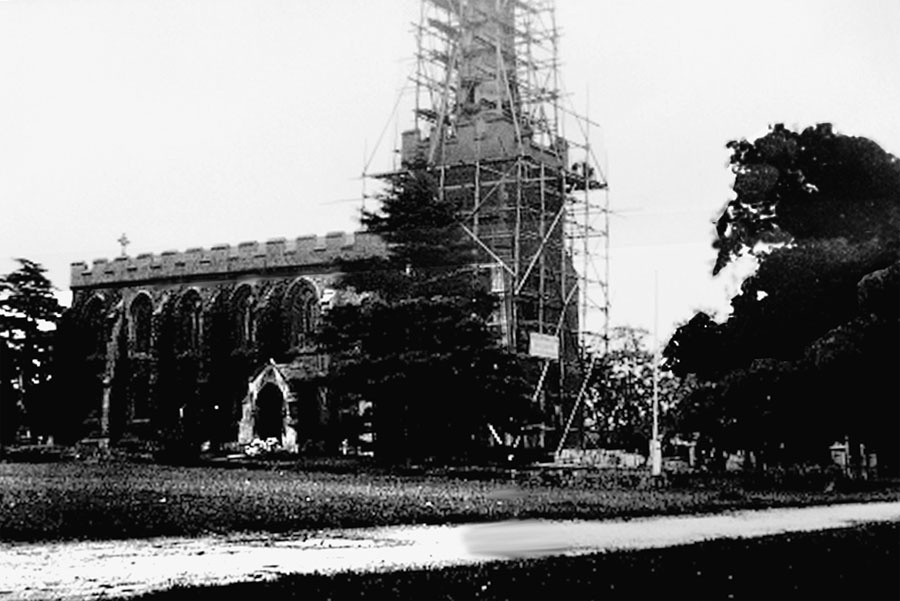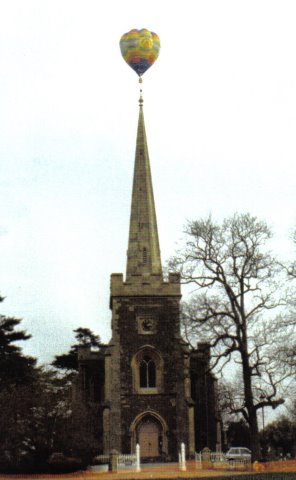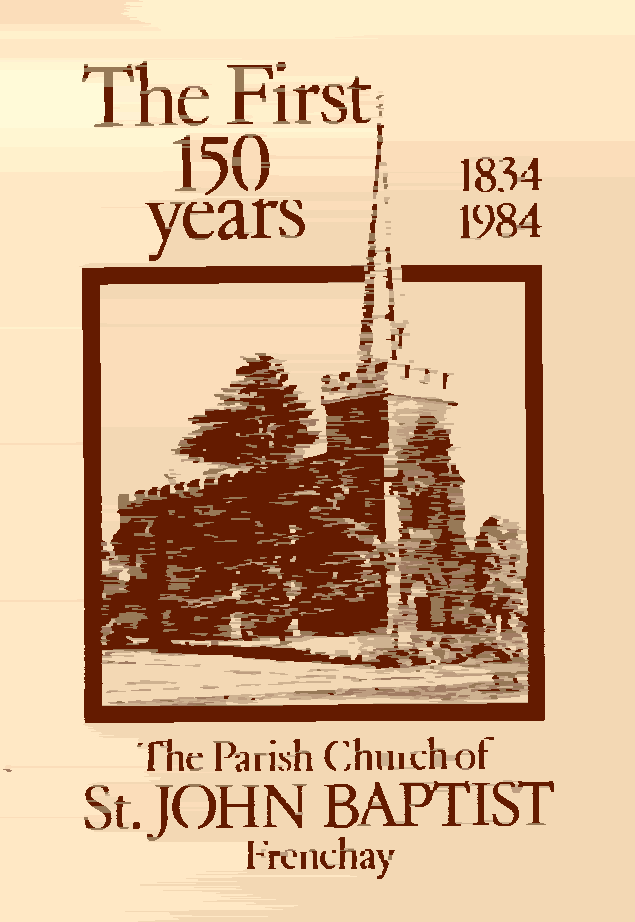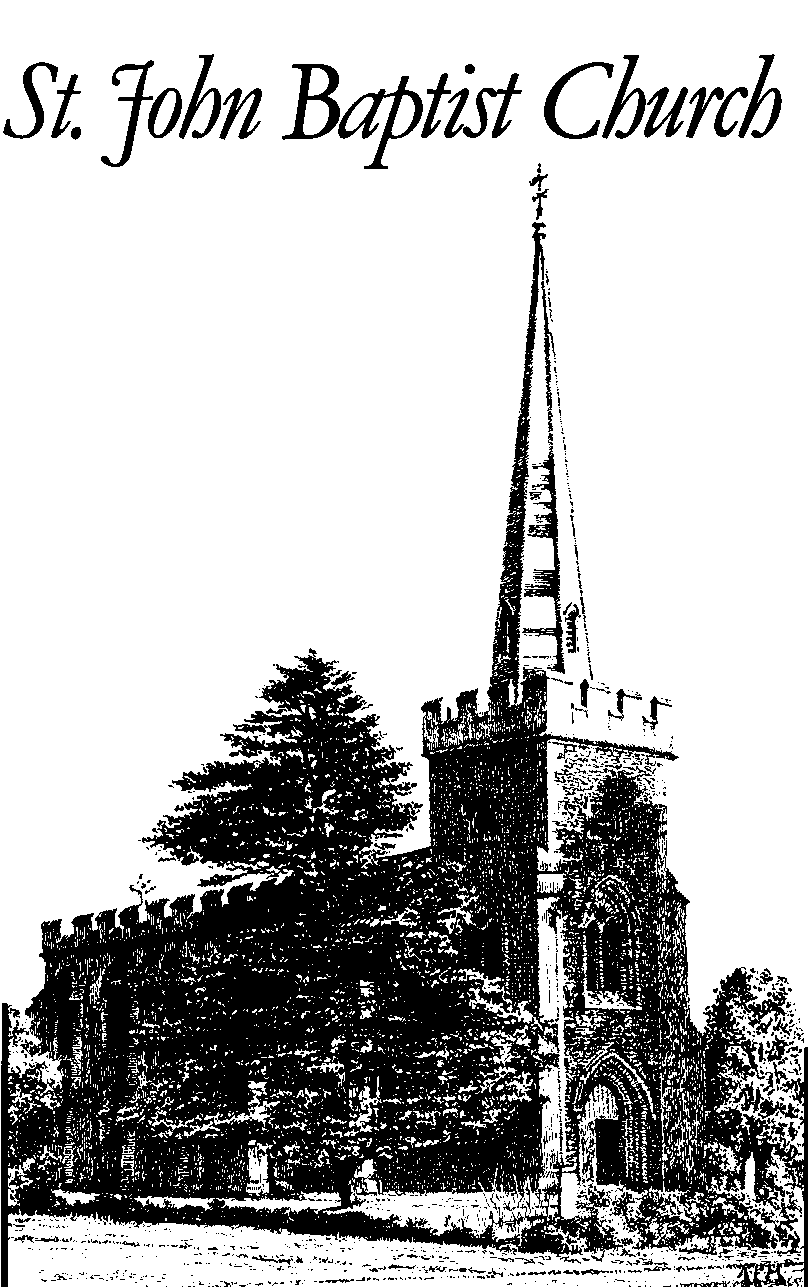 «Home
«Home «Home «Home |
Guide to Frenchay Church
FRENCHAY
|
|
reprinted from
"The First 150 years 1834-1984:
The Parish Church of St JOHN BAPTIST Frenchay"
by Kate Davison and Louise Powell» original cover
» illustration of churchRectors of Frenchay
Thomas Chandler Curties 1837-1840
John Carter BD 1835-1875
Aubrey Lackington Moore MA 1875-1880
Frederick Edward warren DD 1880-1890
Henry Deane DD 1890-1892
William Brooke MA 1892-1911
Cyril Travers Burges MA 1911-1924
Edward Maitland Bald MA 1924-1935
Geoffrey Frederick Greenup MA 1936-1956
William G Reed MA 1956-1961
William GHR Parr 1962-1973
H Barry Trotter BSc 1973-1981
Roger James Thomas BA 1981-In the early 19th century Frenchay was a small community in the ecclesiastical Parish of Winterbourne, but, whereas "dissenters" had had their places of worship, namely the Unitarian Chapel and the Friends Meeting House since the late seventeenth century, Anglicans had to make the 3-mile journey to their Parish church at Winterbourne.
Mr George Worrall, of the Park (now Frenchay Hospital) and other wealthy Anglicans felt they must bring the church to Frenchay. Mr. Worrall gave land on the Common, and a Grant from the Incorporated Church Building Society, together with subscriptions, enabled the church to be built.
On 21st August 1834, the Act of Consecration took place, of the new Church or Chapel of Ease at Frenchay, in the Parish of Winterbourne. Winterbourne Parish church could only seat 500 of the 2,889 people in the Parish; the new Chapel of St. John Baptist "afforded accommodation for 800 persons, including 500 free seats for the use of the poor".
At first the new church remained part of the Parish of Winterbourne, but after the incumbent of Winterbourne resigned his living, division into two parishes was possible, though confusion as to when this separation occurred became so intense that in 1841 there had to be » "an act to remove doubts as to the division of the Parish of Winterbourne in the County of Gloucester, into two parishes". This Act stated that the legal division had become effective from the Order in Council of 27th May 1836 - so baptisms and marriages carried out by the Rector of Frenchay from that date were valid.
In March 1835 the Reverend John Carter became minister, and a select Vestry of 24 "substantial inhabitants" was formed. From the start the most time-consuming business of the Vestry was to raise funds to defray church expenses; as early as 1838 £150 was needed for church repairs. Meetings could be ill-attended, then as now. A meeting in 1842 had to be adjourned because apart from the church wardens only two vestrymen came. Financial problems were temporarily eased in 1847 by a gift of £1,000 to liquidate current expenses. The following year the Sexton was awarded an annual payment of thirty shillings, for ringing the bell for the daily afternoon service.
Disaster struck towards the end of 1856 when the church was robbed; a house to house collection was organised to make good the losses, and, (perhaps a case of shutting the stable door after the horse had bolted) the church was insured in the Phoenix Fire Office, for £1,000.
The minutes of the select vestry meetings for the 19th century are interesting for the indirect information they give about Frenchay society of the time. Meetings were held at 10 am, often on a Monday. Presumably this was acceptable to "substantial inhabitants ". Gradually the minutes change, as time is found to thank people formally for their services, and increased sensitivity led the curate of 1857 to move "that the urinals attached to the church walls are "unseemly" and should be removed "to some convenient part of the churchyard " (thirty years later their removal from the north porch was requested).
In 1861 Frenchay lost a third of its parishioners with the formation of the new Parish of Winterbourne Down, that land on the Winterbourne side of Bradley Brook being taken from Frenchay. Within Frenchay financial matters were again uppermost with topics ranging from repairs to the roof to payment to choir boys, to offerings for the sick and needy. The late 1870s and 1880s were a time when plans were made to change the physical structure of the church. Extensive plans to alter the nave, chancel and tower had to be abandoned because the offer to pay for them was conditional upon the provision of a faculty pew, on terms unacceptable to the bishop. But other alterations, such as removing part of the north gallery to make room for a new organ, the provision of new choir stalls, altar table, and font, went ahead. Other discussion points of around 1880, when Aubrey Moore was rector, could belong to 1980: the church heating needed running repairs, a gate was rotten and needed replacing, and part of the spire needed repointing.
AUBREY MOORE. One of the most well known of Frenchay's rectors was the Revd. Aubrey Moore. He was the incumbent at Frenchay from 1876 to 1881 ... the only part of his adult life not spent at Oxford University ... and left with a great affection for the place and the people. At Oxford he was a teacher, a preacher, a lecturer and a writer. Moore taught Philosophy and Ecclesiastical History (of the Reformation period) but he was particularly admired for his ability to reconcile religious belief with science. Theories of evolution were being argued over, and Moore's writings, especially "The Christian Doctrine of God , which appeared in "Lex Mundi " were regarded as lucid and well balanced, likely to be of help to many others. New academic duties were being offered to Moore and his reputation was such that he was invited by the Bishop of New York to visit America to lecture on "The Religious bearings of Modern Science ". But the influenza epidemic of 1890 claimed him as a victim, and the former rector of Frenchay died, aged just 42. He was described at the time as combining strength and tenderness, as occupying a unique position; "the very best, purest and most potent influence that I have ever known in any human friend or helper".
In 1886 it was decided that it would be a good idea if the choir wore surplices, and 22 ladies offered to make them. Extended vestry space was needed, with a cupboard for the new surplices, and the tender received for the building work as £38. 10. 0d. . . . though £3 was saved by substituting deal for pitch pine in the construction of the cupboard.
The Queen's Jubilee celebrations provoked considerable discussion the following year. The provision of a scholarship to a bright pupil, or the purchase of a parish fire engine, were both suggested, and a further meeting was called. It is interesting to read that a current practice was already well established; the meeting was to be advertised by a notice in the Post Office window! Eventually a dinner for the elderly, a tea for the children, and music, a bonfire and fireworks on the Common were among the activities arranged.
But life was not all jollity. A new parish bier was purchased in 1889, and two palls. Child mortality then was much higher than it is now; one of the palls was for children. Detailed rules were compiled for the use of the bier, and the cost set at 1/- for parishioners and 2/6d for others. Coffins had to be buried at least three feet deep, the charge here being 3/-per foot for the first six feet, and 4/- for the seventh and eighth.
By 1891 Frenchay Ecclesiastical Parish contained 1172 acres and a population of 1132 (513 males and 619 females). There were 247 houses. About the turn of the century work was carried out on the church heating. The hot air ducts were replaced by a system of hot water pipes around the church. Attention was paid to improving the tidiness of the church yard.
Fire insurance values for the church, organ and windows, were raised, and discussion took place about the proposed new parish room and the provision of bicycle shelters. £174.19.6d was spent on re-flooring and on seating alterations, with the provision of a centre aisle. Also at this time Cathedral glass was put in, first in one window "to see the effect", then in the Queen Victoria window, and gallery windows, and finally throughout the church. Insurance premiums were raised accordingly.
The church's longest serving Churchwarden was W. Pearce, who died in 1906. Mr. Pearce was elected churchwarden for the 32nd, and final time in 1906, and a carved credence table was put in the church as a memorial to him. Although continuity among churchwardens benefits the parish, it was thought desirable that two of the sidesmen should retire annually "so that the number of men having an insight into church work should be increased", though no resolution to this effect was ever passed.
Parish affairs were subordinated to national ones in 1912. The Disestablishment of the Welsh church was being proposed and Frenchay sent a resolution demanding "uncompromising resistance " to "disestablishing and disbanding the church in Wales ", to members of Parliament including Asquith and Bonar Law. The following year another protest to Parliament was made.
The first World War disrupted life in Frenchay, as it did elsewhere. In 1913 the vestry meeting had recorded the problem of the church gate being pushed open by animals on the common; by 1916 the church insurance premium had gone up, to include insurance against damage by aircraft.
There was a debt on the upkeep of the Village Hall where lettings were few because of the war. The striking of the church clock was to stop until further notice. A new boiler and new hymn books for the choir were needed in 1917 and finances continued to cause difficulties. Weekly income (from collections) to the Churchwardens' Fund was £2.2.6d, whereas weekly expenditure was £2.18.0d. Frenchay was unable to contribute to the Bishop's 1918 Appeal for £5,000, for Diocesan war needs. An extra penny per week from every church member should be sufficient to end the problem. "Like most other things in these times our religion must cost more. Unlike some things it is well worth the price".
A Remembrance crucifix for the churchyard was presented and dedicated during 1917, and a Roll of 136 Frenchay men who had served was presented to be hung in the church porch. The church's Memorial was completed shortly after.
After the war, church attendance dropped, as did attendance at vestry meetings. By 1920 it was no longer felt incumbent upon the church to provide a general summer treat for all the village children ... only those who went to Sunday School had any just claim upon the church. At the other end of the age range it was thought worth noting that, of the 17 burials in the year up to 1920, 8 were of people aged over 70 years.
Acetylene gas was installed in the church in 1921, but frequently caused disquiet by almost becoming extinguished during services, so that electric lighting was installed in 1927, at a cost of £103.12.8d (including the faculty). The number of communicants was still dropping, but the presence of a new rector meant a big turnout, of 30 or 40, at the vestry meeting of 1925. The state of the roads near the church caused concern during the next 5 years or so; letters were sent to the Parish Council but no positive results are recorded (however in 1964 when work was very necessary the church had the road re-surfaced). Church attendances were again rising by 1930.
After the first World War, Vestry meetings were usually held in the evenings. Another change was the growing attendance of women. Before the war women had seldom attended vestry meetings. Of the 30 people present in 1928, 9 were women, and in 1929 11 men were joined by 13 women. In 1940 Miss M. Elliott became the first woman churchwarden, a post she was to hold successfully for 22 years.
In November 1923, during a thunderstorm, the spire was struck by lightning and "huge chunks of stone were hurled incredible distances over the Common". Fortunately nobody was in the vicinity at the time. The stone courses of the spire were removed and laid in order in the churchyard, and re-used when the spire was rebuilt in 1924.

Photograph by » Charles WilliamsBy 1981, weakened and leaking masonry joints, coupled with suspect suspension of the stabilising weight necessitated dismantling and rebuilding the top 15 feet, and providing new stabilising measures.
The second World War meant that Frenchay was temporarily without its usual rector, when Geoffrey Greenup was absent, serving as an army chaplain. David Marcus Brown served as locum tenens from 1940 to 1945.
The stained glass East window was so shaken by bomb blast that renewal was necessary. Changing tastes resulted in clear glass being used with the pleasing effect of the churchyard cedars providing a backdrop. Many changes have been seen since 1945. In 1958 the organ was rebuilt, while in 1961 and 1962 the church was re-wired and additional lighting provided by a suspended centre light. The boiler was worn out by 1964, necessitating a new oil-fired central heating system. The sanctuary was redecorated in 1963 followed by the nave, 6 years later.
During 1979 a Faculty allowed pews at the rear of the nave to be removed, to create an open area, and in the same year new altar frontals were purchased as a memorial to Miss Molly Elliott.
As a result of the Sheffield Report the number of incumbents in the Diocese of Bristol was being reduced. During the 1981 interregnum the Pastoral Committee decided that Revd. Roger Thomas should be licensed as Priest-in-charge of both Frenchay and Winterbourne Down Parishes, despite the fact that the inhabitants of Frenchay now numbered around 4,500.
During the late sixties the form of the Holy Communion as set forth in the 1662 Prayer Book was replaced by Series 1, and later 3, while Rite A is now used for said and sung Communion.
As we look to the future we can only pray that God will guide the hearts and minds of the people in the years ahead, and continue to bless His church of St. John Baptist.
Text by Kate Davison and Louise Powell

Hot-air balloon G-BPBU flying over Frenchay Church

.
